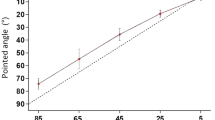Summary
Human motor control has been investigated by applying displacements acting to rotate the shoulder while the subject was endeavouring to maintain a constant position against a pre-existing force delivered by a system of finite stiffness. Four separate stages of the force response were distinguished. First, for the initial 100 msec, an increase in force which was attributed to the visco-elastic properties of activated muscle. Second, after approximately 100 msec, a “medium latency” increase in force accompanied by an increase in EMG activity. Third, a “long latency” increase in force consistent with voluntary action restored the arm to its original position. Fourth, some 500 msec thereafter and dependent upon the final steady force level, a tremor might develop. No changes of force were seen that were of sufficiently short latency to be attributed either to Ia mono-synaptic action or immediately following (within 15 msec) polysynaptic action of muscle mechano-receptors. Even the “medium latency” response was too weak to make an appreciable contribution to restoring the arm to its original position; at the best it provided only 15% of the force required. This response is often considered as a “stretch reflex” responsible for maintaining posture in its own right; for example, by means of a servo-assisted transcortical loop (Marsden et al., 1972). Instead, it is now suggested that it might be a test signal designed to inform the central nervous system of the current loading on the muscle and thus permit the CNS to select an appropriate pre-programmed response from its repertoire of motor actions.
Similar content being viewed by others
References
Allum, J.H.J., Young, L.R.: The relaxed oscillation technique for the determination of the moment of inertia of limb segments. J. Biomechanics (In press, 1975)
Berthoz, A., Roberts, W.J., Rosenthal, N.P.: Dynamic characteristics of stretch reflex using force inputs. J. Neurophysiol. 34, 612–619 (1971)
Burke, R.E.: Control systems operating on spinal reflex mechanisms. Neurosciences research symposium summaries, p. 60–85. Cambridge: M.I.T. Press 1972
Dixon, W.J.: Biomedical Computer Programs. University of California Publications in Automatic Computation 2. University of California Press 1970
Eccles, J.E.: Long loop reflexes from the spinal cord to the brain stem and cerebellum. Atti. Accad. med. lombarda 21, 158–176 (1966)
Eldred, E., Granit, R., Merton, P.A.: Supraspinal control of muscle spindles and its significance. J. Physiol. (Lond.) 122, 498–523 (1953)
Evarts, E.V.: Motor cortex reflexes associated with learned movements. Science 179, 501 (1973)
Goubel, F., Bouisset, S., Lestienne, F.: Determination of muscular compliance in the course of movement. Medicine and Sport, Vol. 6: Biomechanics II. p. 154–158, Basel: Karger 1971
Granit, R.: Receptors and sensory perception. New Haven, Conn.: Yale University Press 1955
Grillner, S.: The role of muscle stiffness in meeting the changing postural and locomotor requirements for force development in the ankle extensors. Acta physiol. scand. 86, 92–108 (1972)
Hammond, P.H.: An experimental study of servoaction in human muscular control. 3rd Int. Cong. on Med. Electronics, p. 190–199 (1960)
Houk, J.C., Singer, J.J., Goldman, M.R.: An evaluation of length and force feedback to soleus muscle of decerebrate cats. J. Neurophysiol. 33, 784–811 (1970)
Jacobsen, S.C.: Control systems for artificial arms. Ph.D. Thesis. Dept. of Mech. Eng. Cambridge, Mass.: M.I.T. 1973
Joyce, G.C., Rack, P.M.H., Westbury, D.R.: The mechanical properties of cat soleus muscle during controlled lengthening and shortening movements. J. Physiol. (Lond.) 204, 461–474 (1969)
Joyce, G.C., Rack, P.M.H.: Isotonic lengthening and shortening movements of cat soleus muscle. J. Physiol. (Lond.) 204, 475–491 (1969)
Lennerstrand, G., Thoden, U.: Muscle spindle responses to concomitant variations in length and fusimotor activation. Acta physiol. scand. 74, 154–165 (1968)
Liddell, E.G.T., Sherrington, C.: Reflexes in response to stretch (myotatic reflexes). Proc. Roy. Soc. B 96, 212–242 (1924)
Marsden, C.D., Merton, P.A., Morton, H.B.: Servoaction in human voluntary control. Nature (Lond.) 238, 140–143 (1972)
Matthews, P.B.C.: The dependence of tension upon extension in the stretch reflex of the soleus muscle of the decerebrate cat. J. Physiol. (Lond.) 147, 521–546 (1959)
Matthews, P.B.C., Stein, R.B.: The sensitivity of muscle spindle afferents to small sinusoidal changes of length. J. Physiol. (Lond.) 202, 59–82 (1969)
Matthews, P.B.C.: The origin and functional significance of the stretch reflex. In: Excitatory synaptic mechanisms (P. Andersen and J.K.S. Jansen, Eds.), p. 301–315. Oslo: Universitetsforlaget 1970
Melvill Jones G., Watt, D.G.D.: Observations on the control of stepping and hopping movements in man. J. Physiol. (Lond.) 219, 709–727 (1971)
Nichols, T.R., Houk, J.C.: Reflex compensation for variations in the mechanical properties of muscle. Science 181, 182 (1973)
Okabe, Y., Rhodes, H.E., Stark, L., Willis, P.A.: Simultaneous hand and eye tracking movements. Quarterly Progress Report, Res. Lab. Elec. M.I.T. p. 395–401 (1962)
Orlovsky, G.N.: Influence of the cerebellum on the reticulo-spinal neurons during locomotion. Biofizika 15, 894–901 (1970)
Orlovsky, G.N.: The effect of different descending systems on flexor and extensor activity during locomotion. Brain Res. 40, 359–371 (1972)
Oscarsson, O.: Functional organisation of the spino and cuneo-cerebellar tracts. Physiol. Rev. 45, 495–582 (1965)
Phillips, C.G.: Motor apparatus of the baboon's hand. Proc. roy. Soc. B 173, 141–174 (1969)
Rack, P.M.H., Westbury, D.R.: The effects of length and stimulus rate on tension in the isometric cat soleus muscle. J. Physiol. (Lond.) 204, 443–460 (1969)
Vallbo, A.B.: The significance of intramuscular receptors in load compensation during voluntary contractions in man. In: Control of Posture and Locomotion. (R.B. Stein, K.G. Pearson, R.S. Smith and J.B. Redford, ed.). p. 211–226. Plenum Press 1973
Wilkie, D.R.: The relation between force and velocity in human muscle. J. Physiol. (Lond.) 110, 249–280 (1950)
Author information
Authors and Affiliations
Rights and permissions
About this article
Cite this article
Allum, J.H.J. Responses to load disturbances in human shoulder muscles: The hypothesis that one component is a pulse test information signal. Exp Brain Res 22, 307–326 (1975). https://doi.org/10.1007/BF00234772
Received:
Issue Date:
DOI: https://doi.org/10.1007/BF00234772




